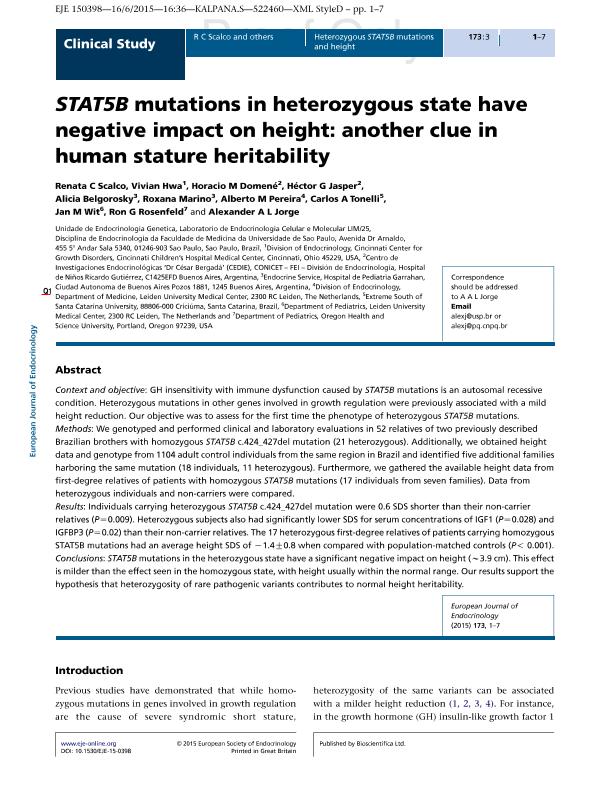Mostrar el registro sencillo del ítem
dc.contributor.author
Scalco, Renata C.
dc.contributor.author
Hwa, Vivian
dc.contributor.author
Domene, Horacio Mario

dc.contributor.author
Jasper, Hector Guillermo

dc.contributor.author
Belgorosky, Alicia

dc.contributor.author
Marino, Roxana
dc.contributor.author
Pereira, Alberto M.
dc.contributor.author
Tonelli, Carlos A.
dc.contributor.author
Wit, Jan M.
dc.contributor.author
Rosenfeld, Ron G.
dc.contributor.author
Jorge, Alexander A. L.
dc.date.available
2016-11-16T21:25:37Z
dc.date.issued
2015-06
dc.identifier.citation
Scalco, Renata C.; Hwa, Vivian; Domene, Horacio Mario; Jasper, Hector Guillermo; Belgorosky, Alicia; et al.; STAT5B mutations in heterozygous state have negative impact on height: another clue in human stature heritability.; Bioscientifica; European Journal Of Endocrinology; 173; 3; 6-2015; 1-17
dc.identifier.issn
0804-4643
dc.identifier.uri
http://hdl.handle.net/11336/8275
dc.description.abstract
Context and objective: GH insensitivity with immune dysfunction caused by STAT5B mutations is an autosomal recessivecondition. Heterozygous mutations in other genes involved in growth regulation were previously associated with a mildheight reduction. Our objective was to assess for the first time the phenotype of heterozygous STAT5B mutations.Methods: We genotyped and performed clinical and laboratory evaluations in 52 relatives of two previously describedBrazilian brothers with homozygous STAT5B c.424_427del mutation (21 heterozygous). Additionally, we obtained heightdata and genotype from 1104 adult control individuals from the same region in Brazil and identified five additional familiesharboring the same mutation (18 individuals, 11 heterozygous). Furthermore, we gathered the available height data fromfirst-degree relatives of patients with homozygous STAT5B mutations (17 individuals from seven families). Data fromheterozygous individuals and non-carriers were compared.Results: Individuals carrying heterozygous STAT5B c.424_427del mutation were 0.6 SDS shorter than their non-carrierrelatives (PZ0.009). Heterozygous subjects also had significantly lower SDS for serum concentrations of IGF1 (PZ0.028) andIGFBP3 (PZ0.02) than their non-carrier relatives. The 17 heterozygous first-degree relatives of patients carrying homozygousSTAT5B mutations had an average height SDS of K1.4G0.8 when compared with population-matched controls (P! 0.001).Conclusions: STAT5B mutations in the heterozygous state have a significant negative impact on height (w3.9 cm). This effectis milder than the effect seen in the homozygous state, with height usually within the normal range. Our results support thehypothesis that heterozygosity of rare pathogenic variants contributes to normal height heritability.
dc.format
application/pdf
dc.language.iso
eng
dc.publisher
Bioscientifica

dc.rights
info:eu-repo/semantics/openAccess
dc.rights.uri
https://creativecommons.org/licenses/by-nc-sa/2.5/ar/
dc.subject
Stat5b
dc.subject
Heterozygous
dc.subject
Mutations
dc.subject.classification
Endocrinología y Metabolismo

dc.subject.classification
Medicina Clínica

dc.subject.classification
CIENCIAS MÉDICAS Y DE LA SALUD

dc.title
STAT5B mutations in heterozygous state have negative impact on height: another clue in human stature heritability.
dc.type
info:eu-repo/semantics/article
dc.type
info:ar-repo/semantics/artículo
dc.type
info:eu-repo/semantics/publishedVersion
dc.date.updated
2016-11-11T16:51:10Z
dc.journal.volume
173
dc.journal.number
3
dc.journal.pagination
1-17
dc.journal.pais
Reino Unido

dc.journal.ciudad
Bristol
dc.conicet.avisoEditorial
“Disclaimer: this is not the definitive version of record of this article.This manuscript has been accepted for publication in Eur J Endocrinol, but the version presented here has not yet been copy-edited, formatted or proofed. Consequently, Bioscientifica accepts no responsibility for any errors or omissions it may contain. The definitive version is now freely available at http://dx.doi.org/10.1530/EJE-15-0398, 2015
dc.description.fil
Fil: Scalco, Renata C.. Universidade de Sao Paulo; Brasil
dc.description.fil
Fil: Hwa, Vivian. Cincinnati Center for Growth Disorders; Estados Unidos
dc.description.fil
Fil: Domene, Horacio Mario. Consejo Nacional de Investigaciones Científicas y Técnicas. Oficina de Coordinación Administrativa Parque Centenario. Centro de Investigaciones Endocrinológicas; Argentina
dc.description.fil
Fil: Jasper, Hector Guillermo. Consejo Nacional de Investigaciones Científicas y Técnicas. Oficina de Coordinación Administrativa Parque Centenario. Centro de Investigaciones Endocrinológicas; Argentina
dc.description.fil
Fil: Belgorosky, Alicia. Gobierno de la Ciudad de Buenos Aires. Hospital de Pediatría "Juan P. Garrahan"; Argentina. Consejo Nacional de Investigaciones Científicas y Técnicas; Argentina
dc.description.fil
Fil: Marino, Roxana. Gobierno de la Ciudad de Buenos Aires. Hospital de Pediatría "Juan P. Garrahan"; Argentina
dc.description.fil
Fil: Pereira, Alberto M.. Leiden University Medical Center; Países Bajos
dc.description.fil
Fil: Tonelli, Carlos A.. Universidade do Extremo Sul Catarinense; Brasil
dc.description.fil
Fil: Wit, Jan M.. Leiden University Medical Center; Países Bajos
dc.description.fil
Fil: Rosenfeld, Ron G.. Oregon Health and Science University; Estados Unidos
dc.description.fil
Fil: Jorge, Alexander A. L.. Universidade de Sao Paulo; Brasil
dc.journal.title
European Journal Of Endocrinology

dc.relation.alternativeid
info:eu-repo/semantics/altIdentifier/url/https://www.ncbi.nlm.nih.gov/pmc/articles/PMC4898761/
dc.relation.alternativeid
info:eu-repo/semantics/altIdentifier/doi/http://dx.doi.org/10.1530/EJE-15-0398
dc.relation.alternativeid
info:eu-repo/semantics/altIdentifier/url/http://www.eje-online.org/content/173/3/291.long
dc.relation.alternativeid
info:eu-repo/semantics/altIdentifier/url/https://pubmed.ncbi.nlm.nih.gov/26034074/
Archivos asociados
